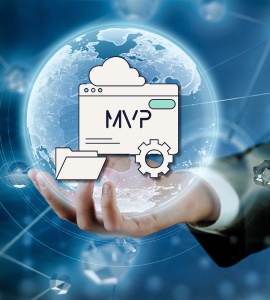In today’s fast-moving digital landscape, speed and efficiency are everything. Startups and enterprises alike face immense pressure to innovate quickly while minimizing risk. That’s where Minimum Viable Product (MVP) development comes in, a proven strategy to validate ideas, attract early adopters, and refine products based on real-world feedback.
At Experion, we specialize in turning visionary ideas into high-impact MVPs. Our approach blends lean methodology, agile execution, and user-centric design to help businesses launch faster, spend smarter, and scale confidently.
But what exactly is an MVP? How does it differ from a prototype or a proof of concept? And how can you ensure your MVP succeeds?
Browse the Sections:
- Understanding Minimum Viable Product (MVP)
- What is MVP in Software Development?
- Key elements of an MVP
- Difference between MVP, Prototype, and POC
- Benefits of MVP Software Development
- The Minimum Viable Product Development Process: Step-by-Step
- Common Mistakes in MVP Development
- Tools and Technologies for MVP Software Development
- When to Move Beyond MVP?
- How to Choose the Right MVP Software Development Services Partner
- Conclusion
- Key Takeaways
Understanding Minimum Viable Product (MVP)
 The concept of an MVP, Minimum Viable Product, was popularized by Eric Ries in his groundbreaking work on the Lean Startup methodology. At its core, the MVP approach challenges the traditional product development mindset that often favors building complete, feature-rich solutions from day one. Instead, it encourages creators to think lean, act fast, and learn constantly.
The concept of an MVP, Minimum Viable Product, was popularized by Eric Ries in his groundbreaking work on the Lean Startup methodology. At its core, the MVP approach challenges the traditional product development mindset that often favors building complete, feature-rich solutions from day one. Instead, it encourages creators to think lean, act fast, and learn constantly.
An MVP is not a prototype or a stripped-down version of a final product, it is a functional and testable version that contains just enough core features to deliver value to its early users. These early adopters play a crucial role in shaping the product by offering real-world feedback, validating core assumptions, and identifying what works (and what doesn’t).
The power of MVP lies in its intentional simplicity. It helps businesses avoid the common trap of overbuilding features that may never be used or needed. Rather than spending months (or even years) developing a polished product in isolation, teams using the MVP approach focus on solving one core problem really well, launching early, and iterating based on validated learning.
Key to this methodology is the cycle of Build – Measure – Learn:
- Build a minimal version of the product that targets a specific need or problem.
- Measure how users interact with it through meaningful metrics and feedback.
- Learn what needs to change, improve, or pivot to meet market demands effectively.
-
This approach is especially valuable in today’s fast-paced, innovation-driven digital landscape, where speed-to-market, adaptability, and resource efficiency can make or break a product’s success.
Whether you’re a startup founder testing a new business idea or an enterprise validating a new feature for your platform, the MVP is your launchpad for smarter product decisions and lower-risk innovation.
Why Build Big When You Can Build Smart?
→ Let us help you prioritize the features that matter most, get in touch!
What is MVP in Software Development?

In software development, a Minimum Viable Product (MVP) is a streamlined version of a digital product that includes only its essential features, the ones absolutely necessary to solve a specific user problem or fulfill a focused business need. It’s not about cutting corners; it’s about prioritizing value, speed, and learning.
MVPs are built with intentional minimalism to allow teams to release early, gather real user data, and validate product-market fit before scaling up or investing in full-scale development. The purpose is to test hypotheses around usability, functionality, and demand while keeping development lean and purposeful.
Key Elements of an MVP
- Core Functionality Only
MVPs prioritize the must-have features that deliver the product’s main value proposition. No bells and whistles, just what users need to derive value and provide honest feedback. - Built to Validate Assumptions
MVPs are tools for learning, not just launching. They help you test key assumptions, like whether your target audience actually wants or understands your solution, without committing to full-scale production. - Rapid to Develop
Time is of the essence. MVPs are designed to be built and launched quickly, allowing for faster iterations, quicker pivots, and a shorter feedback loop with users. -
Difference Between MVP, Prototype, and POC
- Prototype
A prototype is a non-functional visual model of the product, often used to test design concepts, user flows, and UX before coding begins. Think of it as a clickable mockup. - Proof of Concept (POC)
A POC is a technical experiment that validates whether a specific approach or technology can solve a problem. It’s often used internally to verify feasibility before committing to product development. - Minimum Viable Product (MVP)
An MVP is a working, functional version of the product, launched to real users with the goal of gathering feedback and validating the core idea. It’s the first usable release in your product’s lifecycle. -
Benefits of MVP Software Development
Building an MVP isn’t just a strategy, it’s a smart business decision. It enables startups and enterprises to minimize risks, optimise resources, and learn early from real users.
Faster Time to Market
Launching an MVP means you can bring your idea to life and into the hands of users much sooner. This accelerates market entry, which is crucial in competitive or fast-moving industries.
Lower Development Costs
MVPs focus only on what’s necessary, helping you avoid bloated budgets and unnecessary complexity. You invest just enough to build, test, and improve based on evidence, not assumptions.
Real User Feedback Early
Instead of building in isolation, MVP development gives you insightful feedback from actual users early in the process. This helps shape product decisions and feature priorities based on real-world needs.
Reduced Risk of Product Failure
Many products fail due to poor market fit or misunderstood user needs. MVPs allow you to test those risks early, course-correct quickly, and make informed, data-driven decisions.
Investor Confidence & Stakeholder Buy-In
Demonstrating early user engagement, clear market interest, or even modest revenue can significantly boost investor and stakeholder confidence. It shows traction and reduces perceived risk, increasing the chances of further funding or organizational support.
Scale Confidently from MVP to Full Product!
→ Partner with us to build a scalable, future-ready product, let’s connect!
The Minimum Viable Product Development Process: Step-by-Step
 Turning an idea into a functioning MVP isn’t just about writing code, it’s a structured, iterative journey that spans product discovery, design, development, launch, and continuous learning. Here’s how successful minimum viable product software development unfolds:
Turning an idea into a functioning MVP isn’t just about writing code, it’s a structured, iterative journey that spans product discovery, design, development, launch, and continuous learning. Here’s how successful minimum viable product software development unfolds:
Idea Validation
Before investing resources, you need to ensure your idea solves a real problem.
- Market Research: Understand the industry landscape, customer pain points, and existing solutions. Identify gaps and opportunities.
- Competitor Analysis: Examine direct and indirect competitors. What are they doing well? Where are they falling short?
- Problem-Solution Fit: Validate whether your proposed product is the right solution for the identified problem. Talk to potential users, gather feedback, and refine your idea accordingly.
-
The goal here is to back your idea with evidence, not assumptions.
Define the Core Features
Your MVP should do one thing exceptionally well, and that begins with feature prioritization.
- Prioritization Techniques: Use proven methods like MoSCoW (Must, Should, Could, Won’t) or the Kano Model to separate essentials from nice-to-haves.
- Feature Matrix: Map out features based on impact vs. effort to create a clear, strategic scope for development.
-
Focus on building just what’s needed to test your core value proposition.
Designing the User Flow
A well-thought-out user journey is key to delivering value quickly and intuitively.
- User Journey Mapping: Outline the end-to-end user experience, from entry point to task completion.
- Wireframes & UX: Design wireframes to define layout, interactions, and flow. Even an MVP should feel intuitive and easy to use.
-
Good UX design increases engagement and drives better feedback, even in early stages.
MVP Tech Stack Selection
Your technology choices should support fast development without limiting future scalability.
- Decision Factors: Consider performance, scalability, team expertise, and budget.
- Popular MVP Stacks: Lightweight, agile stacks like React + Firebase, Flutter, Node.js, and AWS Amplify are ideal for quick builds with robust capabilities.
-
The right tech stack balances speed today with growth tomorrow.
Development & Iteration
This is where your MVP comes to life, iteratively and incrementally.
- Agile Methodology: Break down development into sprints, focusing on delivering working features in cycles.
- CI/CD Pipelines: Automate testing, integration, and deployment for faster, reliable releases.
-
Iteration is the heartbeat of MVP development, build, release, refine.
Testing the MVP
Testing ensures that even a minimal product is stable, usable, and aligned with user expectations.
- Functional Testing: Verify that all implemented features work correctly.
- Usability Testing: Ensure the product is intuitive, accessible, and user-friendly.
- Beta Testing: Engage early adopters to identify real-world usage issues and uncover insights.
-
Testing is not a checkpoint; it’s a continuous, valuable input for learning.
Launching the MVP
Getting your MVP into users’ hands the right way can make all the difference.
- Soft Launch Strategy: Start with a limited release to a select audience. This controlled exposure allows for refinement.
- Launch Channels: Use targeted outreach, email campaigns, online communities, product platforms, and social media, to gather initial users.
-
Think of your launch as a learning event, not a finish line.
Measure & Learn
Post-launch, the real magic happens: data-driven learning.
- Track Key Metrics: Focus on KPIs such as Daily Active Users (DAU), retention rate, churn, conversion, and user engagement.
- Feedback Tools: Leverage tools like Hotjar, Mixpanel, Google Analytics, or Amplitude to monitor behavior and collect actionable insights.
-
Use insights to iterate fast, refine your value proposition, and shape your long-term roadmap.
At Experion…
We don’t just build MVPs, we build product journeys.
At every step, from ideation to iteration, we anchor our development in real-world validation and user-centric thinking. Our approach blends design, engineering, and market understanding to create MVPs that don’t just launch, but lead. Every sprint moves your product closer to sustainable success.
Common Mistakes in MVP Development
- Building Too Many Features: MVP ≠ Miniature Final Product.
- Ignoring User Feedback: Early feedback is your MVP’s lifeblood.
- Poor UI/UX Decisions: Even MVPs need good design.
- Skipping Market Validation: Build what people need—not what you think they want.
- Not Planning for Scale: Think ahead, even if you’re starting small.
-
Tools and Technologies Used by MVP Software Development Company
- Design: Figma, Sketch, Adobe XD
- Development: React, Flutter, Node.js, Firebase, AWS Amplify
- Project Management: Jira, Trello, Notion
- Testing & Analytics: Postman, Hotjar, Google Analytics, Mixpanel
-
When to Move Beyond MVP?
MVP serves a critical purpose: to validate whether your product idea resonates with users and has the potential to scale. But how do you know when it’s time to take the next step and move beyond MVP?
You’ve Validated Product-Market Fit
One of the clearest signs that it’s time to evolve past the MVP stage is strong product-market fit. This means that your solution is not only solving a real problem but that users are actively choosing your product over alternatives—and sticking with it. You’ll start seeing consistent usage patterns, repeat engagement, and organic growth through referrals or word-of-mouth.
Your KPIs Tell a Positive Story
MVPs are built for learning, and metrics are the language of that learning. When your key performance indicators (KPIs) start showing positive trends—such as rising daily active users (DAUs), strong retention rates, increasing conversions, and low churn—it’s a sign that your product is not just functional, but valuable.
Moreover, qualitative signals like positive user feedback, increased feature requests, or unsolicited testimonials are equally powerful indicators that it’s time to invest in scaling.
You’re Ready to Build Version 1.0
With validation and data in hand, the next logical step is transitioning to a full-fledged product, Version 1.0. This stage involves:
- Scaling infrastructure to handle larger user volumes
- Building out secondary features and integrations
- Improving UI/UX based on feedback
- Introducing performance and security enhancements
- Possibly implementing monetization strategies or advanced analytics
-
At this point, you’re no longer just testing hypotheses, you’re building for long-term growth and sustainability.
MVPs: The Smartest First Step for Startups and Innovators!
→ Let’s craft your MVP and turn your vision into reality!
How to Choose the Right MVP Software Development Services Partner

Building an MVP is not just about coding, it’s about understanding the business problem, user needs, and market dynamics. Choosing the right partner can be the difference between a product that simply launches and one that grows and thrives.
Here’s what you should look for:
Proven Experience in Lean Product Development
Your ideal partner should have a strong track record of delivering MVPs that have gone on to become successful full-scale products. Look for a partner who embraces Lean Startup principles, build quickly, validate early, and iterate fast.
Experion has built MVPs for startups and enterprises across diverse sectors, ensuring each product is market-relevant, technically sound, and user-focused.
Domain Knowledge and Industry Expertise
A partner with experience in your industry will understand your challenges and opportunities more intuitively. They’ll bring strategic insight into regulatory considerations, user behavior, and competitive landscape that can shape smarter MVP decisions.
At Experion, our domain-first approach means our teams come prepared, with industry context, business acumen, and a deep understanding of vertical-specific trends.
Agile Development Process
MVPs require speed and flexibility. The right partner will follow an agile methodology, delivering in sprints, adapting to change, and collaborating transparently. Regular feedback loops, stand-ups, sprint retrospectives, and demos should be standard practice.
Experion’s agile teams are structured to iterate rapidly without compromising on quality, empowering product owners to make informed decisions at every stage.
Transparent Communication and Support
Successful MVP development depends heavily on clear, consistent communication. Your partner should offer proactive updates, clear documentation, and accessible team structures, including product managers, designers, engineers, and QA specialists.
Experion’s client engagement model ensures open lines of communication, collaborative decision-making, and responsive support, even post-launch.
Case Studies and Client Testimonials
Before making your decision, review a prospective partner’s portfolio. Look for case studies that highlight MVP success stories, user adoption metrics, and innovation outcomes. Testimonials from past clients can also give you insight into the partner’s reliability and quality.
Experion’s portfolio features success stories from startups that scaled rapidly post-MVP and enterprises that launched successful internal products—all backed by measurable outcomes.
At Experion, our custom MVP software development services are designed to deliver more than code—we deliver momentum. By combining business insight with technical excellence, we help our clients make confident, informed product decisions that lay the foundation for long-term success.
Conclusion
Minimum Viable Product (MVP) development is not just a technique, it’s a philosophy of innovation. In a world where speed, adaptability, and user feedback determine success, MVPs provide a powerful framework for launching smart and scaling fast.
Whether you’re a first-time startup founder or a product leader at a large enterprise, building an MVP allows you to validate your ideas in the real world, gather actionable insights, and minimize the risk of building something nobody wants. Instead of overcommitting time and resources to an untested product vision, you create a feedback-driven loop that guides smarter, more impactful decisions.
And yet, the MVP is just the beginning. It is your opportunity to:
- Test assumptions with minimal risk
- Learn from real users
- Iterate based on data, not guesswork
- Attract early adopters and potential investors
- Build toward a product that people love and rely on
-
-
As your MVP gains traction, the transition to a scalable, feature-rich Version 1.0 becomes a strategic evolution, not a leap of faith.
Key Takeaways
- Launch quickly to validate real market demand
- Save development costs by avoiding unnecessary complexity
- Test assumptions early before scaling
- Use metrics to guide product decisions, not guesswork
- Let real user feedback shape your roadmap
- Avoid feature overload in the first release
- Gain stakeholder and investor confidence with early traction
- Build on a scalable foundation from the start
- Iterate fast using agile development practices
- Reduce time to insight with real-world usage data
- Work with experienced teams who understand lean product thinking
- Minimize risk while maximizing learning
- Start small, scale with clarity and confidence
-
Experion combines technical rigor, agile execution, and human-centered design to create MVPs that aren’t just minimal, they’re meaningful. Whether your vision is to disrupt, digitize, or differentiate, we help you get there, one validated step at a time.

